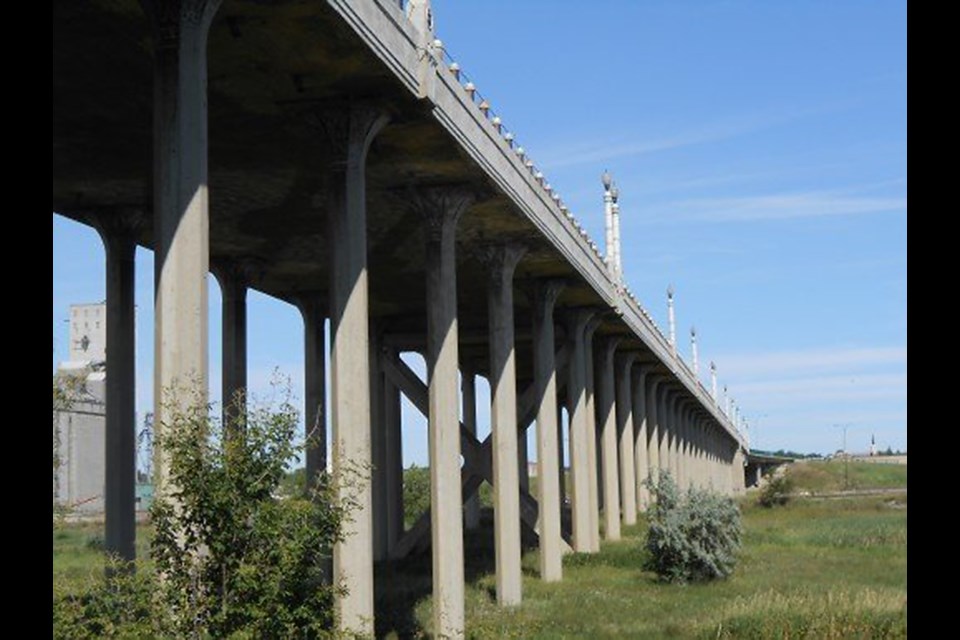The dispute between city hall and Canadian Pacific Railway about paying to fix the Fourth Avenue Bridge is nothing new, as both parties squabbled during a similar dispute in the late 1980s.
Based on an agreement the municipality and CP Rail — now Canadian Pacific Kansas City — signed when the Thunderbird Viaduct opened in 1929, the rail company was responsible for maintaining the centre steel span while the municipality was responsible for maintaining the road and concrete work, according to material in the Moose Jaw Public Library archives.
Both parties began conversations in 1984 — 55 years after the structure was built — about rebuilding the bridge.
In January 1986, the city imposed a 10-tonne limit on the bridge after an engineer’s report indicated the centre span was deteriorating. However, the rail company never provided city hall or city council with the engineer’s full report, only recommendations about how to repair the bridge.
Options were to shore up the centre span or replace the section altogether, even though this would “foul traffic for some time,” according to a Regina Leader-Post article.
In September 1987, council hired Saskatoon’s C.C.D. Engineering (Western) Ltd. at $226,547 to repair the bridge, which was the lowest of all bids received but still higher than the project estimate of $160,000. These repairs included concrete work on sidewalks, curbs, parapet walls and miscellaneous work.
City engineer Al Schwinghamer said the city would not have to close the bridge during this construction phase but would shutter it during the second phase in 1988.
Officials believed the bridge would be finished by 1988 at the latest.
Council also agreed to a CP Rail proposal to split the project cost of roughly $1.2 million, to accept $200,000 from the company so the municipality had full maintenance control in the future, and accept $50,000 to modify the bridge’s design to include decorative features.
In late September, the project’s cost jumped to $1.4 million because CPR said contractors would have to perform work in the winter — something the city wanted to avoid. This increased the cost-sharing for each party to $760,000.
In February 1988, price estimates rose to $4.2 million, with the steel span expected to cost $1.2 million and the concrete work projected to be $3 million. Around this time, the province agreed to pay 67 per cent of the concrete work because the bridge was part of the province’s highway network.
On June 30, 1988, the city closed the bridge because another engineer’s report deemed it unsafe — the welds were “suspect” — with municipal officials saying the closure would last 10 months.
An article from July 1988 indicated that CP Rail refused to accept responsibility for replacing the steel truss section. Furthermore, negotiations bogged down after the city asked the company to cost share for the concrete work.
“(City commissioner Jim) Bennett said negotiations have been protracted primarily because CP rail is not able to make decisions locally and all proposals must be reviewed by Vancouver and Montreal offices,” a Times-Herald article from August 1988 said.
The company subsequently turned down the entire cost-sharing proposal, but the city launched a court action and the National Transportation Agency (NTA) became involved.
“In its (final) ruling, the NTA said responsibility for the reconstruction cost of the steel portion of the bridge lies solely with CP Rail … and the concrete portion with the city,” a Leader-Post article from September 1988 said.
Around this time, South Hill businesspeople approached council to explain how much money they were losing.
One hotel owner said his food losses were 15 per cent and his bar sales were down 20 per cent. A pizza shop owner said his customers had declined 5.9 per cent. A drug store put an expansion on hold, while the 7-11 saw a 29-per-cent drop in sales.
In November 1988, city officials said work to remove the old steel span would occur in January or February 1989, while the bridge was expected to open in the fall of 1989. Meanwhile, a Times-Herald article indicated the bridge was the focus of most debate during that fall’s civic election.
An article from May 1989 said the city planned to start its work later that month, while CP Rail would remove the steel section beginning that June.
Finally, after 18 months of closure, vehicles began rolling over the Fourth Avenue Bridge on Nov. 28, 1989. Alderman Mel Stern and Mayor Stan Montgomery were the first to officially cross the bridge in a car, although a few pedestrians and cyclists had already made the trek.
CP paid roughly $1.2 million to restore the steel span, while the city paid over $2.2 million — the province covered 67 per cent — for the concrete and deck work.




